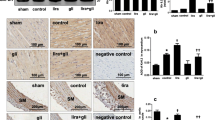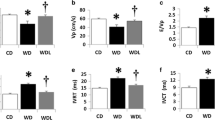Abstract
Sustained left ventricular hypertrophy (LVH) accelerates cardiac dysfunction and heart failure. Previous reports have suggested that activation of the peroxisome proliferator-activated receptor γ (PPARγ)-dependent pathway is involved in development of cardiac hypertrophy. Thiazolidinediones (TZDs) such as pioglitazone activate PPARγ and are clinically used as antidiabetics. Given inconsistent reports regarding effects of TZDs on LVH, we examined in the present study the influence of pioglitazone on LVH in a rat model of aortic banding. Aortic banding was induced in rats by clipping the ascending aorta. Animals received pioglitazone (3 mg/kg/day) or placebo. Echocardiographic, hemodynamic, histological, and biochemical measurements were performed after 2 and 4 weeks. Pressure gradient was comparable between pioglitazone- and placebo-treated animals after 2 and 4 weeks. Left ventricular function was not different between the groups. In sham as well as in banded animals, LV/body weight ratio was increased in pioglitazone- as compared to placebo-treated animals after 2 and 4 weeks. Furthermore, an increase in myocyte size and atrial natriuretic factor was observed in pioglitazone- compared to placebo-treated animals 4 weeks after aortic banding as well. The results of this study demonstrate that activation of PPARγ via pioglitazone does not protect the myocardium from pressure overload-induced LVH in a rat model of aortic banding. The findings rather indicate a pro-hypertrophic effect of pioglitazone treatment after aortic banding.





Similar content being viewed by others
References
Arakawa K, Ishihara T, Aoto M, Inamasu M, Kitamura K, Saito A (2004) An antidiabetic thiazolidinedione induces eccentric cardiac hypertrophy by cardiac volume overload in rats. Clin Exp Pharmacol Physiol 31:8–13
Asakawa M, Takano H, Nagai T, Uozumi H, Hasegawa H et al (2002) Peroxisome proliferator-activated receptor gamma plays a critical role in inhibition of cardiac hypertrophy in vitro and in vivo. Circulation 105:1240–1246
Balakumar P, Singh M (2006) Possible role of poly(ADP-ribose) polymerase in pathological and physiological cardiac hypertrophy. Methods Find Exp Clin Pharmacol 28:683–689
Bell D, McDermott BJ (2005) Effects of rosiglitazone and interactions with growth-regulating factors in ventricular cell hypertrophy. Eur J Pharmacol 508:69–76
Bishop-Bailey D (2000) Peroxisome proliferator-activated receptors in the cardiovascular system. Br J Pharmacol 129:823–834
Chen Z, Ishibashi S, Perrey S, Osuga J, Gotoda T et al (2001) Troglitazone inhibits atherosclerosis in apolipoprotein E-knockout mice: pleiotropic effects on CD36 expression and HDL. Arterioscler Thromb Vasc Biol 21:372–377
Collins AR, Meehan WP, Kintscher U, Jackson S, Wakino S et al (2001) Troglitazone inhibits formation of early atherosclerotic lesions in diabetic and nondiabetic low density lipoprotein receptor-deficient mice. Arterioscler Thromb Vasc Biol 21:365–371
Duan SZ, Ivashchenko CY, Russell MW, Milstone DS, Mortensen RM (2005) Cardiomyocyte-specific knockout and agonist of peroxisome proliferator-activated receptor-gamma both induce cardiac hypertrophy in mice. Circ Res 97:372–379
Fajas L, Auboeuf D, Raspe E, Schoonjans K, Lefebvre AM et al (1997) The organization, promoter analysis, and expression of the human PPARgamma gene. J Biol Chem 272:18779–18789
Festuccia WT, Laplante M, Brule S, Houde VP, Achouba A et al (2009) Rosiglitazone-induced heart remodelling is associated with enhanced turnover of myofibrillar protein and mTOR activation. J Mol Cell Cardiol 47:85–95
Geng DF, Wu W, Jin DM, Wang JF, Wu YM (2006) Effect of peroxisome proliferator-activated receptor gamma ligand. Rosiglitazone on left ventricular remodeling in rats with myocardial infarction. Int J Cardiol 113:86–91
Ghazzi MN, Perez JE, Antonucci TK, Driscoll JH, Huang SM et al (1997) Cardiac and glycemic benefits of troglitazone treatment in NIDDM. The Troglitazone Study Group. Diabetes 46:433–439
Goldberg RB, Kendall DM, Deeg MA, Buse JB, Zagar AJ et al (2005) A comparison of lipid and glycemic effects of pioglitazone and rosiglitazone in patients with type 2 diabetes and dyslipidemia. Diabetes Care 28:1547–1554
Guan Y, Hao C, Cha DR, Rao R, Lu W et al (2005) Thiazolidinediones expand body fluid volume through PPARgamma stimulation of ENaC-mediated renal salt absorption. Nat Med 11:861–866
Horio T, Suzuki M, Suzuki K, Takamisawa I, Hiuge A et al (2005) Pioglitazone improves left ventricular diastolic function in patients with essential hypertension. Am J Hypertens 18:949–957
Hsiao A, Worrall DS, Olefsky JM, Subramaniam S (2004) Variance-modeled posterior inference of microarray data: detecting gene-expression changes in 3T3-L1 adipocytes. Bioinformatics 20:3108–3127
Ito H, Nakano A, Kinoshita M, Matsumori A (2003) Pioglitazone, a peroxisome proliferator-activated receptor-gamma agonist, attenuates myocardial ischemia/reperfusion injury in a rat model. Lab Invest 83:1715–1721
Iwase M, Bishop SP, Uechi M, Vatner DE, Shannon RP et al (1996) Adverse effects of chronic endogenous sympathetic drive induced by cardiac GS alpha overexpression. Circ Res 78:517–524
Levy D, Garrison RJ, Savage DD, Kannel WB, Castelli WP (1990) Prognostic implications of echocardiographically determined left ventricular mass in the Framingham Heart Study. N Engl J Med 322:1561–1566
Li AC, Brown KK, Silvestre MJ, Willson TM, Palinski W, Glass CK (2000) Peroxisome proliferator-activated receptor gamma ligands inhibit development of atherosclerosis in LDL receptor-deficient mice. J Clin Invest 106:523–531
Marfella R, D'Amico M, Esposito K, Baldi A, Di Filippo C et al (2006) The ubiquitin-proteasome system and inflammatory activity in diabetic atherosclerotic plaques: effects of rosiglitazone treatment. Diabetes 55:622–632
Minamikawa J, Tanaka S, Yamauchi M, Inoue D, Koshiyama H (1998) Potent inhibitory effect of troglitazone on carotid arterial wall thickness in type 2 diabetes. J Clin Endocrinol Metab 83:1818–1820
Nesto RW, Bell D, Bonow RO, Fonseca V, Grundy SM et al (2003) Thiazolidinedione use, fluid retention, and congestive heart failure: a consensus statement from the American Heart Association and American Diabetes Association. October 7, 2003. Circulation 108:2941–2948
Nissen SE, Wolski K (2007) Effect of rosiglitazone on the risk of myocardial infarction and death from cardiovascular causes. N Engl J Med 356:2457–2471
Olefsky JM (2000) Treatment of insulin resistance with peroxisome proliferator-activated receptor gamma agonists. J Clin Invest 106:467–472
Pickavance LC, Tadayyon M, Widdowson PS, Buckingham RE, Wilding JP (1999) Therapeutic index for rosiglitazone in dietary obese rats: separation of efficacy and haemodilution. Br J Pharmacol 128:1570–1576
Qayyum R, Schulman P (2006) Cardiovascular effects of the thiazolidinediones. Diabetes Metab Res Rev 22:88–97
Rangwala SM, Lazar MA (2004) Peroxisome proliferator-activated receptor gamma in diabetes and metabolism. Trends Pharmacol Sci 25:331–336
Rose M, Balakumar P, Singh M (2007) Ameliorative effect of combination of fenofibrate and rosiglitazone in pressure overload-induced cardiac hypertrophy in rats. Pharmacology 80:177–184
Sakai S, Miyauchi T, Irukayama-Tomobe Y, Ogata T, Goto K, Yamaguchi I (2002) Peroxisome proliferator-activated receptor-gamma activators inhibit endothelin-1-related cardiac hypertrophy in rats. Clin Sci (Lond) 103(Suppl 48):16S–20S
Sena S, Rasmussen IR, Wende AR, McQueen AP, Theobald HA et al (2007) Cardiac hypertrophy caused by peroxisome proliferator- activated receptor-gamma agonist treatment occurs independently of changes in myocardial insulin signaling. Endocrinology 148:6047–6053
Shiomi T, Tsutsui H, Hayashidani S, Suematsu N, Ikeuchi M et al (2002) Pioglitazone, a peroxisome proliferator-activated receptor-gamma agonist, attenuates left ventricular remodeling and failure after experimental myocardial infarction. Circulation 106:3126–3132
Son NH, Park TS, Yamashita H, Yokoyama M, Huggins LA et al (2007) Cardiomyocyte expression of PPARgamma leads to cardiac dysfunction in mice. J Clin Invest 117:2791–2801
Yamamoto K, Ohki R, Lee RT, Ikeda U, Shimada K (2001) Peroxisome proliferator-activated receptor gamma activators inhibit cardiac hypertrophy in cardiac myocytes. Circulation 104:1670–1675
Yuan Z, Liu Y, Zhang J, Kishimoto C, Wang Y et al (2003) Peroxisome proliferation-activated receptor-gamma ligands ameliorate experimental autoimmune myocarditis. Cardiovasc Res 59:685–694
Yue Tl TL, Chen J, Bao W, Narayanan PK, Bril A et al (2001) In vivo myocardial protection from ischemia/reperfusion injury by the peroxisome proliferator-activated receptor-gamma agonist rosiglitazone. Circulation 104:2588–2594
Zhang H, Zhang A, Kohan DE, Nelson RD, Gonzalez FJ, Yang T (2005) Collecting duct-specific deletion of peroxisome proliferator-activated receptor gamma blocks thiazolidinedione-induced fluid retention. Proc Natl Acad Sci U S A 102:9406–9411
Acknowledgements
The work presented herein was supported by the Deutsche Forschungsgemeinschaft (HA 2959/2-2) to SEH.
The authors would like to acknowledge the expert technical assistance of Silvia Harrack. We also want to thank Karl Heinz Weiss for helpful comments to the manuscript.
Author information
Authors and Affiliations
Corresponding author
Rights and permissions
About this article
Cite this article
Weiss, C.S., Hagenmüller, M., Pichler, M. et al. Activation of PPARγ by pioglitazone does not attenuate left ventricular hypertrophy following aortic banding in rats. Naunyn-Schmied Arch Pharmacol 381, 285–295 (2010). https://doi.org/10.1007/s00210-009-0488-7
Received:
Accepted:
Published:
Issue Date:
DOI: https://doi.org/10.1007/s00210-009-0488-7




